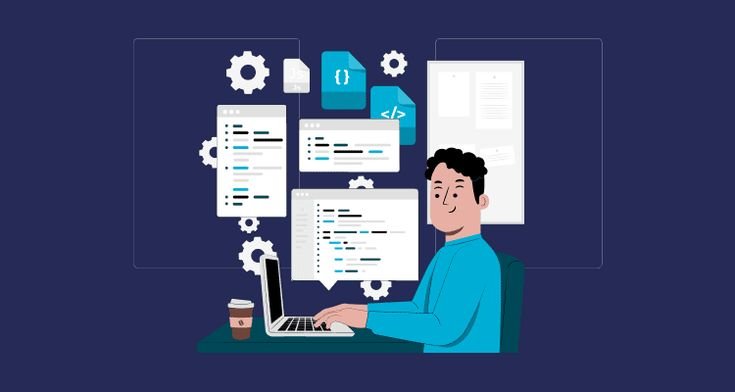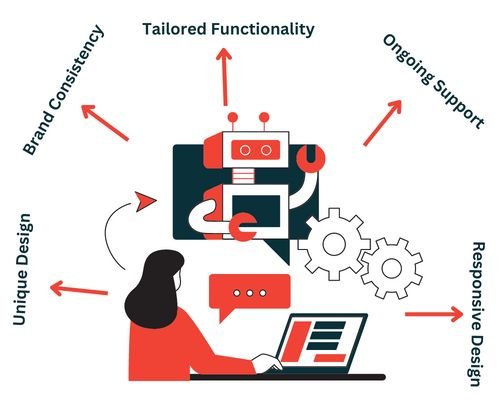Building a website in 2025 isn’t just about design or content anymore. It’s also about how that website is built: whether you choose low code or full code.
This choice determines how quickly you can launch, how much flexibility you have, and how well your site will scale as your business grows.
So, what do these two terms actually mean?
Low code refers to a development approach that uses drag-and-drop visual interfaces, pre-built templates, and minimal manual coding.
Platforms like Webflow, Bubble, and Wix’s advanced developer mode are examples of low-code tools.
They make it possible to build dynamic websites faster, even with limited technical expertise. The trade-off?
You’re often restricted by the platform’s structure, meaning deep customization or unique integrations can be harder to achieve.
Full code, on the other hand, is the traditional way of building websites. That is, writing code from scratch using programming languages such as HTML, CSS, JavaScript, and frameworks like React or Laravel.
This approach gives you complete control over functionality, performance, and scalability. However, it requires skilled developers, more time, and usually a higher budget.
Both methods have clear advantages depending on your goals. Low code speeds up development and lowers costs. Full code ensures maximum flexibility and control.
The real challenge lies in knowing which one best fits your project’s vision, budget, and long-term growth plans.
Let’s talk about it.
1. Project Scope and Complexit

When you evaluate whether to choose low code or full code for your website you must begin by assessing the scope and complexity of what you’re building.
A website with a few standard pages, simple content updates, and limited integrations is a strong candidate for a low-code path.
In contrast, if your site demands unique business logic, custom APIs, complex workflows, heavy integrations, or enterprise-level security, then a full-code approach becomes more appropriate.
Research comparing full-code versus low-code development emphasises that full code enables the highest level of customisation and control, while low code offers a compromise between speed and flexibility.
Platforms that deliver low-code development allow reuse of components and visual design tools, but they may still fall short when you need very bespoke functionalities.
That difference becomes crucial when you ask: Can this website evolve easily, will new features be required, or is the underlying architecture critical to success?
If the answer to any of those is yes, leaning toward full code makes sense.
On the other hand, if you need to launch quickly, test a market, or manage a budget-sensitive project, then the low code route for your website may offer advantages.
In other words, this first factor—project scope and complexity—should drive your decision between low code or full code.
2. Time to Market & Budget
Another key factor in deciding low code or full code for your website is the time to market and the available budget.
Low-code platforms tend to accelerate development because they provide pre-built components, visual editors, and infrastructure that ease build-out.
According to industry analysis, low-code development generally requires less manual coding and thus can reduce delivery time compared to full-code solutions.
That means if you have a tight deadline or are testing a concept, low code may be the more strategic choice.
From a budget standpoint, full-code usually demands more resources: skilled developers, longer development cycles, deeper testing, and higher maintenance overhead.
The total cost of ownership can be higher, especially in early stages. For example, the difference in learning curve and required expertise between approaches is significant.
Therefore if your project must stick to a lean budget, low code or full code becomes a question of trade-offs.
However, choosing low code to save time and money comes with caveats: you might sacrifice some control, extensibility, or performance.
So the decision isn’t simply “we’ll save money so we go low code”; you must weigh how those savings affect your future.
If you anticipate scaling, adding major functionality, or integrating with complex services, full code might pay off despite higher upfront cost.
Ultimately your website strategy must align with how quickly you need to launch, how much you can invest now, and how much you expect to invest later if you choose low code or full code.
3. Customisation, Performance & Control
A major differentiator when choosing low code or full code for your website is the degree of customisation, performance optimisation, and control you require.
Full-code development allows you to build every part of the site from the ground up, tailor every function, optimize for speed, security, and custom behaviour.
As noted by analysts, code solutions offer maximum flexibility and are better suited when performance matters.
If your website demands custom modules, niche business logic, or tight system controls, full code gives you that latitude.

Low-code platforms, in contrast, use pre-built modules and visual editors. While they allow faster assembly and simplification, they often limit how far you can go in customising every aspect.
NinjaOne highlights that low code is ideal for balancing speed and customisation but may not match full-code in advanced scenarios.
This means if you pick low code your website may be fine initially, but eventually you might face constraints in customising deep systems, integrating unusual services, or tweaking performance beyond what the platform allows.
When your website strategy involves heavy traffic, low latency, bespoke architecture, or future features you can’t yet specify, full code gives you long-term control.
If instead your needs are more standard (content pages, e-commerce, modest forms, routine integrations) then low code may offer just enough without the burden of full engineering.
Hence decide based on how much customisation, control and optimisation you expect your website to need as you move from launch to growth.
4. Maintenance, Scalability & Longevity
When evaluating low code or full code for your website you must align with maintenance requirements, scalability potential, and long-term viability.
A website isn’t a one-time build; over time you’ll update, evolve, expand.
Full-code development tends to be more robust for long-term growth: you own the codebase, you can refactor, optimise, integrate deeply, and scale out architecture as needed.
Analysts emphasise that code solutions are better suited for long-term growth and adaptability.
If your website strategy expects major updates, high traffic volumes, or future integrations, full code supports that.
Low-code platforms simplify launch and early updates, but they sometimes face limitations when the website evolves.
Vendor lock-in, constraints on customizing deep architecture, or platform limitations in scaling are real concerns.
For example, articles highlight that while low-code lowers the barrier, it may impose limits in customisation and scalability.
So if your website is expected to evolve into a platform, serve heavy loads, or be transformed in the future, the full code route offers a safer structural foundation.
Another aspect is ongoing maintenance: full-code sites require technical staffing, updates, security patches, and perhaps higher cost over time.
Low-code platforms offload some of that maintenance to the provider or platform, reducing burden for smaller teams.
Your decision should factor in how much you are prepared to invest in maintenance and scalability.
If you anticipate long-term growth and evolving demands, lean toward full code; if your website will remain relatively static or you’ll rely on platform updates, low code could suffice.
5. Team Skills, Governance & Risk
Within the decision between low code or full code for your website, you must also examine your team’s skills, governance structures, and risk tolerance.
Full-code development demands developers with programming expertise, knowledge of security, architecture, system management, and ongoing engineering support.
If your team lacks those resources, choosing full code may lead to delays, quality issues, or hidden costs.
As one analysis puts it: “full-code requires you to develop from the ground up and takes longer” when compared to low-code.
On the other hand, low-code platforms are designed to enable broader teams, including citizen developers or business users, to assemble features with less coding.
The same source states that low-code solutions let you modify visual components while still reaching more than a no-code approach.
However you must still ensure proper governance: platform selection, security controls, best practices, and avoiding technical debt.
Many organisations underestimate the risk of vendor lock-in, limited extensibility, or hidden platform constraints. Analysts highlight those risks.
Thus, if your team is limited in developer expertise, or you want a faster turnaround with less engineering overhead, the low-code path may align better.
But you also have to ensure your governance, architecture standards, maintenance practices, and risk management are fit for the long-term.
In short, pick low code or full code not just on features but on who is building, maintaining, and evolving the website.
6. Future Proofing & Hybrid Strategies

Finally, when deciding between low code or full code for your website in 2025 you should consider future-proofing and the possibility of hybrid strategies.
Very often the best path is not purely one or the other, but a blend. Many recent studies note that organisations can start with low-code components and transition to full code when complexity grows.
This hybrid approach builds speed initially while preserving the option to migrate or extend with full code later.
When you design your site with future changes in mind (think modular architecture, API-first design, composable components) you can more easily switch between low code or full code as needed.
For example, you may launch a portion of your website using low code (for speed) while building core services or integrations with full code.
This gives you both rapid time to market and strong architecture underpinnings.
Another element of future-proofing: platform risk and vendor lock-in. Low-code platforms can change pricing, features, or become deprecated.
Full-code gives you full ownership but requires more investment.
Observers point out that low code or no-code solutions have limitations in performance and customisation when scaling.
By planning early for this and creating abstraction layers in your website design, you retain flexibility.
In effect, the choice of low code or full code should include your view on where the website will be in 3–5 years.
Are you planning incremental growth, major new features, integrations, or large user volumes? If yes, build with full code or a hybrid path.
If your website remains more static or budget constrained, low code may be entirely suitable.
Conclusion
Choosing between low code or full code for your website is not a trivial decision. It impacts cost, speed, flexibility, control, and long-term capability.
Throughout this article we examined six powerful factors. By aligning your website vision with these factors you’re far more likely to pick the right approach.
If your website needs are relatively simple, you’re working under budget and timeline constraints, and you plan modest growth, then low-code offers a compelling, efficient path.
If instead your website must scale significantly, integrate deeply, support custom functionality, or serve as a strategic digital platform, then full-code is the stronger choice.
In 2025 there is no one-size-fits-all answer. The right answer is the one that matches your website’s goals, your team’s capacity, and your roadmap.
Take the time to evaluate thoroughly, include all stakeholders in the decision, and build with an approach you can maintain and evolve.
With that clarity you’ll move ahead confidently, knowing you selected low code or full code with purpose, not habit.